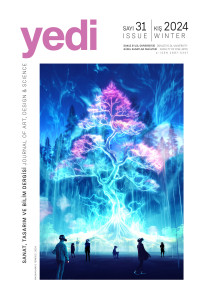Abstract
Irony, as the creative strategy of the Conceptual Photography movement that breaks the monotony in the context of language ability, offers a questioning form of expression. The meanings in its language, fiction and indirect expression are conveyed through various layers of visual language. Ironic designs, which have established an extraordinary interaction with the human mind from ancient times to the present day, pointing to what is behind the visible, have attracted the audience to the paradox of reality and its opposite. Considering the dynamic and wide area of influence that the concept has gained from its historical development to the present, it can be seen that it remains up-to-date. Global technologies cover all areas of mass communication and direct intellectual and semantic perception policies. Today, a complex visual reading and interpretation experience emerges through the use of the concepts of reality and illusion. Determining the levels of ironic language and imagery is necessary in order to make the meaning shifts and meanings more understandable. In this study, it is aimed to examine the historical development of ironic expression forms and fictions and to determine their character extending to their current use in the context of conceptual photography with examples. In addition, Joan Fontcuberta was examined through her works, within the framework of the descriptive method, by considering the relationship between the level of ironic language and current photographic expression.
References
- Bahtin, M. (2020). Karnavaldan romana (C. Soydemir, Çev.) Ayrıntı Yayınları.
- Behler, E. (2008). Antikçağda ironinin ortaya çıkışı (O. Türkay, Çev.). Cogito, 57, 20–24.
- Bircan, U. (2016). Sokrates’ten Kierkegaard’a ironi. Sosyal Bilimler Araştırma Dergisi, 27, 79-110.
- Booth, W.C. (2016). İroninin retoriği (S. Sarı, Çev.). Hece Yayınları.
- Cebeci, O. (2008). Tarihsel bir perspektif üzerinden ironi tür ve tekniklerinin gelişimi. Cogito, 57, 87-104.
- Duchamp, M. (1913). Bisiklet tekerleği. https://listelist.com/marcel-duchamp-kimdir/
- Eldagsen, B. (2023). The electrician. https://www.eldagsen.com/sony-world-photography-awards-2023/
- Flusser, V. (1991). Bir fotoğraf felsefesine foğru (İ. Derman, Çev.). Hece Yayınları.
- Fontcuberta, J. (2019-21). Prosopagnosia. https://www.artsy.net/artwork/joan-fontcuberta-prosopagnosia
- Fontcuberta, J. (2023). Projectes. https://www.fontcuberta.com/wp/projectes
- Göktan, M.Ç. (2014). Kavramsal fotoğraf (Tez No. 368536) [Sanatta yeterlik tezi, Kocaeli Üniversitesi]. Ulusal Tez Merkezi.
- Güçbilmez, B. (2005). Sophokles’ten Stoppard’a ironi ve dram sanatı. Deniz Kitabevi.
- Hutcheon, L. (2020). Postmodernizmin poetikası (Y. Balcı, Çev.). Metis Yayınları.
- Kertesz, A. (1928) Fork. https://www.moma.org/interactives/objectphoto/objects/83802.html
- Kierkegaard, S. (2020). İroni kavramı (S. Okur, Çev.). İmge Kitabevi Yayınları.
- Madoz, C. (2016). Untitled. https://www.artsy.net/artist/chema-madoz?page=6&medium=
- Manovich, L. (2020). Cultural analytics. The MIT Press.
- Öngün, C. (2020). Generative adversarial networks (GAN) nedir? https://cihanongun.medium.com/generative-adversarial-networks-gan-nedir-5cc6a48a6870
- Özgen, O. (2020). Kavramsal fotoğraf bağlamında Chema Madoz (Tez No. 635921) [Yayınlanmamış yüksek lisans tezi, Dokuz Eylül Üniversitesi]. Ulusal Tez Merkezi.
- Özgen, O. (2022). Post-Fotoğraf ve ironi. S. Atay, E.E. Ercan (Ed.), Post-Fotoğraf (s. 48-71) içinde. Eğitim Yayınevi.
- Polat, N. ve Uzun. İ. M. (2019). Kavramsal sanat sunuş. Teorik Bakış Dergisi, 13, 15.
- Yurt, C. (2020). Postmodernite ve ironi: Nietzsche & Rorty. Urzeni Yayınevi.
- Zizek, S. (2006). The parallax view. The MIT Press.
Abstract
Kavramsal Fotoğraf hareketinin dil yetisi bağlamında tekdüzeliği kıran yaratıcı stratejisi olarak ironi sorgulayıcı bir ifade biçimi sunmaktadır. Dili ve kurgusu ile dolaylı anlatımındaki anlamlar, çeşitli görsel dil katmanlarıyla taşınmaktadır. Antik Çağ’dan günümüze insan zihniyle görünenin arkasındakini işaret eden sıra dışı bir etkileşim kuran ironik tasarımlar, gerçek ve onun zıddı ile izleyicisini paradoksa çekmiştir. Kavramın tarihsel gelişiminden bugüne kazandığı dinamik ve geniş etki alanı dikkate alındığında güncelliğini koruduğu görülmektedir. Küresel teknolojiler kitle iletişiminin tüm alanlarını kapsayarak düşünsel ve anlamsal algı politikalarını yönlendirmektedir. Günümüzde gerçeklik ve yanılsama kavramlarının kullanımları üzerinden karmaşık bir görsel okuma ve anlamlandırma deneyimi ortaya çıkmaktadır. İronik dil ve görüntü düzeylerinin belirlenmesi karşılaşılan anlam kaymaları ve anlamların daha anlaşılır kılınması açısından gereklidir. Bu çalışmada ironik ifade biçimleri ve kurguların tarihsel gelişimi incelenerek, kavramsal fotoğraf bağlamındaki güncel kullanımlarına uzanan karakterinin örneklerle belirlenmesi hedeflenmiştir. Bununla beraber Joan Fontcuberta çalışmaları üzerinden, betimsel yöntem çerçevesinde, ironik dil düzeyi ile güncel fotografik ifade ilişkisi ele alınarak incelenmiştir.
References
- Bahtin, M. (2020). Karnavaldan romana (C. Soydemir, Çev.) Ayrıntı Yayınları.
- Behler, E. (2008). Antikçağda ironinin ortaya çıkışı (O. Türkay, Çev.). Cogito, 57, 20–24.
- Bircan, U. (2016). Sokrates’ten Kierkegaard’a ironi. Sosyal Bilimler Araştırma Dergisi, 27, 79-110.
- Booth, W.C. (2016). İroninin retoriği (S. Sarı, Çev.). Hece Yayınları.
- Cebeci, O. (2008). Tarihsel bir perspektif üzerinden ironi tür ve tekniklerinin gelişimi. Cogito, 57, 87-104.
- Duchamp, M. (1913). Bisiklet tekerleği. https://listelist.com/marcel-duchamp-kimdir/
- Eldagsen, B. (2023). The electrician. https://www.eldagsen.com/sony-world-photography-awards-2023/
- Flusser, V. (1991). Bir fotoğraf felsefesine foğru (İ. Derman, Çev.). Hece Yayınları.
- Fontcuberta, J. (2019-21). Prosopagnosia. https://www.artsy.net/artwork/joan-fontcuberta-prosopagnosia
- Fontcuberta, J. (2023). Projectes. https://www.fontcuberta.com/wp/projectes
- Göktan, M.Ç. (2014). Kavramsal fotoğraf (Tez No. 368536) [Sanatta yeterlik tezi, Kocaeli Üniversitesi]. Ulusal Tez Merkezi.
- Güçbilmez, B. (2005). Sophokles’ten Stoppard’a ironi ve dram sanatı. Deniz Kitabevi.
- Hutcheon, L. (2020). Postmodernizmin poetikası (Y. Balcı, Çev.). Metis Yayınları.
- Kertesz, A. (1928) Fork. https://www.moma.org/interactives/objectphoto/objects/83802.html
- Kierkegaard, S. (2020). İroni kavramı (S. Okur, Çev.). İmge Kitabevi Yayınları.
- Madoz, C. (2016). Untitled. https://www.artsy.net/artist/chema-madoz?page=6&medium=
- Manovich, L. (2020). Cultural analytics. The MIT Press.
- Öngün, C. (2020). Generative adversarial networks (GAN) nedir? https://cihanongun.medium.com/generative-adversarial-networks-gan-nedir-5cc6a48a6870
- Özgen, O. (2020). Kavramsal fotoğraf bağlamında Chema Madoz (Tez No. 635921) [Yayınlanmamış yüksek lisans tezi, Dokuz Eylül Üniversitesi]. Ulusal Tez Merkezi.
- Özgen, O. (2022). Post-Fotoğraf ve ironi. S. Atay, E.E. Ercan (Ed.), Post-Fotoğraf (s. 48-71) içinde. Eğitim Yayınevi.
- Polat, N. ve Uzun. İ. M. (2019). Kavramsal sanat sunuş. Teorik Bakış Dergisi, 13, 15.
- Yurt, C. (2020). Postmodernite ve ironi: Nietzsche & Rorty. Urzeni Yayınevi.
- Zizek, S. (2006). The parallax view. The MIT Press.
Details
| Primary Language | Turkish |
|---|---|
| Subjects | Photography, Video and Lens-Based Practice |
| Journal Section | Araştırma Makaleler |
| Authors | |
| Publication Date | January 29, 2024 |
| Submission Date | August 24, 2023 |
| Acceptance Date | October 4, 2023 |
| Published in Issue | Year 2024 Issue: 31 |

